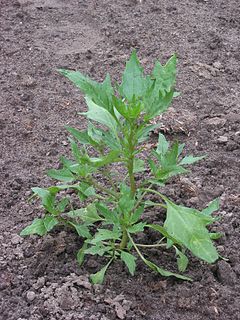
Oxybasis rubra(syn. Chenopodium rubrum), common names red goosefoot or coastblite goosefoot, is a member of the genus Oxybasis, a segregate of Chenopodium. It is native to North America and Eurasia. It is an annual plant.

Puccinellia is a genus of plants in the grass family, known as alkali grass or salt grass.

Orthilia is a genus of flowering plant in the family Ericaceae. It has only one species, Orthilia secunda. Its common names are sidebells wintergreen, one-sided-wintergreen and serrated-wintergreen. It is also called one-sided pyrola, one-sided shinleaf, and one-sided wintergreen. It was previously part of genus Pyrola, the wintergreens.
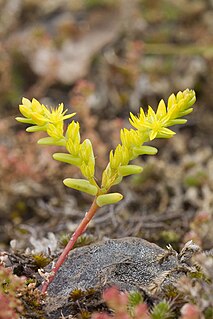
Sedella pumila is a species of flowering plant in the family Crassulaceae known by the common name Sierra mock stonecrop. It is native to California, where it grows in the North Coast Ranges and adjacent sections of the Central Valley to the Sierra Nevada foothills. It is a plant of vernal pools and similar habitat, growing in rocky and gravelly flats of serpentine soils, limestone, and soils of volcanic origin, often alongside mosses. This is an annual herb growing 2 to 17 centimeters high, in shades of green, yellow, and red. It has small knobby succulent leaves each a few millimeters long. The flowers atop the threadlike stems have fleshy sepals and yellowish petals a few millimeters in length. The flowers have a musty scent.

Poa glauca is a species of grass known by the common names glaucous bluegrass, glaucous meadow-grass and white bluegrass. It has a circumboreal distribution, occurring throughout the northern regions of the Northern Hemisphere. It is also known from Patagonia. It is a common grass, occurring in Arctic and alpine climates and other areas. It can be found throughout the Canadian Arctic Archipelago in many types of habitat, including disturbed and barren areas.

Puccinellia distans is a species of grass known by the common names weeping alkaligrass and European alkali grass. It is native to Europe and it is present in most of North America, where it is perhaps an introduced species. It grows in moist habitat, usually in areas with saline soils, such as the edges of salted roads. It is a perennial herb producing hollow stems up to 40 to 60 centimeters in maximum height. The inflorescence is a spreading array of branches, the lower ones reflexed. The branches bear several rough-haired spikelets containing flowers.
Puccinellia howellii is a rare species of grass known by the common name Howell's alkaligrass. It is endemic to Shasta County, California, where it is known from a single population in Whiskeytown National Recreation Area near Whiskeytown. Its entire population is contained in a 1-acre (4,000 m2) complex of three saline mineral springs directly next to Highway 299. The grass was first described to science in 1990 and no other populations were discovered despite extensive searches of the area.

Puccinellia lemmonii is a species of grass known by the common name Lemmon's alkaligrass. It is native to western North America, particularly the northwestern United States, where it grows in moist, saline soils.
Puccinellia nutkaensis is a species of grass known by the common names Nootka alkaligrass and Alaska alkali grass. It is native to North America from Alaska across northern Canada to Greenland and Nova Scotia, and down to Washington to Oregon to the Central Coast of California.

Puccinellia nuttalliana is a species of grass known by the common name Nuttall's alkaligrass. It is native to North America, where it is widespread from Alaska east throughout Canada to Greenland, and common in the western and central United States. It is present in the Arctic, throughout the temperate mountain ranges, the Great Plains, the Great Basin, and along the western coastline of North America down through California.
Puccinellia parishii is an uncommon species of grass known by the common names bog alkaligrass and Parish's alkali grass. It is native to the western United States, where it is known from a few locations in Arizona and New Mexico, and one occurrence each in California and Colorado.

Puccinellia simplex is a species of grass known by the common names California alkaligrass and western alkali grass. It is native to California, where it grows in mineral springs and other moist habitat with saline soils in the Central Valley, Mojave Desert, and other areas. It is also known from Utah, but occurrences there are probably introduced. This annual grass grows up to about 25 centimeters tall. The inflorescence is generally a linear structure with parallel branches bearing small spikelets.

Sagittaria cuneata is a species of flowering plant in the water plantain family known by the common name arumleaf arrowhead or duck potato. Like some other Sagittaria species, it may be called wapato. It is native to much of North America, including most of Canada as well as the western and northeastern United States.

Sporobolus airoides is a species of grass known by the common name alkali sacaton. It is native to western North America, including the Western United States west of the Mississippi River, British Columbia and Alberta in Canada, and northern and central Mexico. It grows in many types of habitat, often in alkali soils, such as in California desert regions.
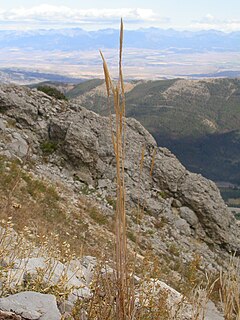
Trisetum spicatum is a species of grass known by the common name spike trisetum and spike false oat. It is native to North America, Eurasia, and South America. In North America it occurs throughout northern regions, including northern sections of the United States and most all of Canada, its range continuing to Greenland. It is widespread throughout the Canadian Arctic Islands. The grass occurs in a variety of Arctic and alpine habitat types, as well as many types of mountainous habitat in regions farther south. It is a perennial grass forming clumps of erect stems ranging in height from just a few centimeters to over one meter. The narrow leaves are mostly located around the bases of the densely clumped stems. The inflorescence is a narrow spike a few centimeters long or up to 30 to 50 centimeters in maximum length. The spikes are green to purple or brownish and shiny.
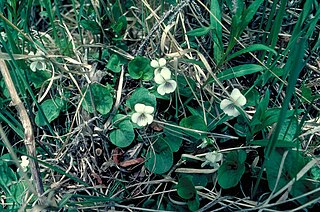
Viola renifolia is a species of violet known by the common names white violet and kidneyleaf violet. It is native to northern North America, where it has a widespread distribution across Canada and the northern United States as far south as Washington, Colorado, and New York.
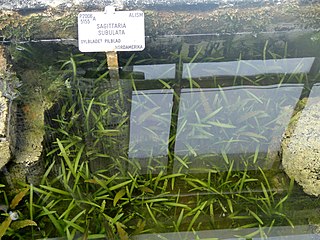
Sagittaria subulata, the awl-leaf arrowhead, narrow-leaved arrowhead or dwarf sagittaria, is an aquatic plant species that grows primarily in shallow brackish water along the seacoast, in marshes, estuaries, etc. It is native to the Republic of Colombia, the District of Columbia, Venezuela, and every US state along the coast from Massachusetts to Louisiana. It has also been reported as naturalized in Great Britain on just three occasions; only one of these is recent and it appears to have become extinct by 2010. It is also recorded as a non-native on the Azores, and on the Island of Java in Indonesia.

Agastache scrophulariifolia, also known as the purple giant hyssop, is a perennial plant that grows throughout the US and Northern Ontario, CN. It is a beneficial plant to pollinators and is noted for its medicinal properties, as many plants in the mint family are. It tends to grow in disturbed or open areas where it does not have to interact with non-native competitive plants.

Solidago latissimifolia, common name Elliott's goldenrod, is North American species of flowering plants in the sunflower family. It is native to the Atlantic Coast of the United States and Canada, from Nova Scotia south to Alabama and Florida.
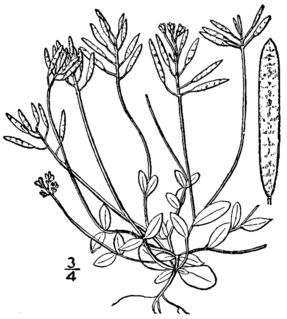
Draba reptans, common names Carolina draba, Carolina whitlow-grass, Creeping whitlow-grass, and Whitlow-grass, is an annual plant in the family Brassicaceae that is native to North America.















